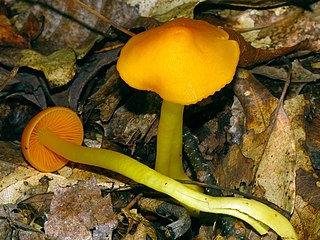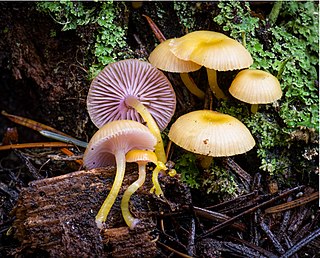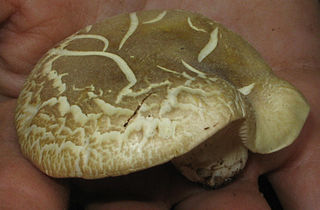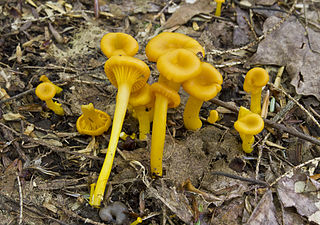| Hygroaster | |
|---|---|
| Scientific classification | |
| Kingdom: | |
| Division: | |
| Class: | |
| Order: | |
| Family: | |
| Genus: | Hygroaster Singer (1955) |
| Type species | |
| Hygroaster nodulisporus (Dennis) Singer (1955) | |
| Species | |
H. agumbensis Contents | |
Hygroaster is a genus of mushroom-forming fungi in the family Hygrophoraceae. [1] The genus was described by mycologist Rolf Singer in 1955. [2]

The Hygrophoraceae are a family of fungi in the order Agaricales. Originally conceived as containing white-spored, thick-gilled agarics, including Hygrophorus and Hygrocybe species, DNA evidence has extended the limits of the family, so it now contains not only agarics, but also basidiolichens and corticioid fungi. Species are thus diverse and are variously ectomycorrhizal, lichenized, associated with mosses, or saprotrophic. The family contains 25 genera and over 600 species. None is of any great economic importance, though fruit bodies of some Hygrocybe and Hygrophorus species are considered edible and may be collected for sale in local markets.

Hygrophorus is a genus of agarics in the family Hygrophoraceae. Called "woodwaxes" in the UK or "waxy caps" in North America, basidiocarps are typically fleshy, often with slimy caps and lamellae that are broadly attached to decurrent. All species are ground-dwelling and ectomycorrhizal and are typically found in woodland. Around 100 species are recognized worldwide. Fruit bodies of several species are considered edible and are sometimes offered for sale in local markets.

Hygrocybe is a genus of agarics in the family Hygrophoraceae. Called waxcaps in English, basidiocarps are often brightly coloured and have waxy to slimy caps, white spores, and smooth, ringless stems. In Europe they are characteristic of old, unimproved grasslands which are a declining habitat, making many Hygrocybe species of conservation concern. Elsewhere they are more typically found in woodlands. Most are ground-dwelling and all are believed to be moss associates. Around 150 species are recognized worldwide. Fruit bodies of several Hygrocybe species are considered edible and are sometimes offered for sale in local markets.

Camarophyllopsis is a genus of 26 species of fungi with a widespread distribution, especially in northern temperate areas. Members of Camarophyllopsis are distinguished from members of the family Hygrophoraceae mainly by their hymenoderm pileipellis. The arrangement of lamellar trama is highly variable between species. Coloration of the fruit body is dull, tending toward browns and grays. Many members of this genus were formerly classified in the genus Hygrotrama, but the two genera were subsequently put in synonymy.

The Tricholomataceae are a large family of mushrooms within the Agaricales. Originally a classic "wastebasket taxon", the family included any white-, yellow-, or pink-spored genera in the Agaricales not already classified as belonging to e.g. the Amanitaceae, Lepiotaceae, Hygrophoraceae, Pluteaceae, or Entolomataceae.

Humidicutis is a small genus of brightly coloured agarics, the majority of which are found in Eastern Australia. They were previously described as members of Hygrocybe. The genus Porpolomopsis is closely related, and the species in it were once placed in Humidicutis. The genus was described by mycologist Rolf Singer in 1959.

Porpolomopsis lewelliniae, commonly known as the mauve splitting wax-cap, is a gilled fungus of the waxcap family found in wet forests of eastern Australia and New Zealand. The small mauve- or lilac-coloured mushrooms are fairly common and appear in moss or leaf litter on the forest floor in autumn, and are biotrophic. The key distinguishing feature is the splitting of the cap dividing down the middle of the individual gills.
Acantholichen is a fungal genus in the family Hygrophoraceae. A monotypic genus, it contains a single species, the basidiolichen Acantholichen pannarioides, discovered originally in Costa Rica in 1998. This species has a bluish, gelatinous thallus, and a fine, white powdery bloom covering the hairy upper surface; this surface is said to resemble "an unshaven chin".
Aeruginospora is a genus of fungi in the family Hygrophoraceae. It was formerly placed in the family Tricholomataceae, but it was moved to the Hygrophoraceae in a recent review of the family based on its morphological similarity to Chrysomphalina and especially Haasiella. It might be that Haasiella, which differs in spore color and ecology, is a junior synonym of Aeruginospora, but this has not yet been tested in a molecular phylogenetics study. The genus, described by Franz Xaver Rudolf von Höhnel in 1908, currently contains two species found in New Zealand and Indonesia. Six species formerly placed in Aeruginospora were transferred to the genus Camarophyllopsis. A. furfuracea might also belong in Camarophyllopsis, but it has not yet been restudied.

Cantharellula is a genus of mushroom-forming fungi in the family Hygrophoraceae. The genus was described by mycologist Rolf Singer in 1936.
Haasiella is a fungal genus in the family Hygrophoraceae. It is a monotypic genus that contains only the species Haasiella splendidissima. Haasiella venustissima, formerly considered to be a distinct species based on its one and two-spored basidia, was found by a DNA study to be synonymous with H. splendidissima. H. splendidissima is only known from Europe and is saprotrophic on wood. Haasiella was described as a new genus in 1966 by Czech mycologists František Kotlaba and Zdeněk Pouzar. It is most closely related to the genus Hygrophorus.

Pseudoarmillariella is a genus of fungi in the family Hygrophoraceae. The genus contains three species found in Central America, North America, and Asia. Pseudoarmillariella was described by mycologist Rolf Singer in 1956.

Chromosera is a genus of fungi in the family Hygrophoraceae. Within the family Hygrophoraceae it is closely related to the genus Gloioxanthomyces. It contains five species. The generic name honors the mycologist Meinhard Moser, and also alludes (chromos) to the distinct coloration of the mushrooms.
Semiomphalina is a basidiolichen genus in the family Hygrophoraceae. The genus is monotypic, containing the single species Semiomphalina leptoglossoides, found in Papua New Guinea.
Dictyonema is a genus of mainly tropical basidiolichens in the family Hygrophoraceae.

Cantharocybe is a genus of mushroom-forming fungi in the family Hygrophoraceae. The genus was described by American mycologists Howard E. Bigelow and Alexander H. Smith in 1973. Cantharocybe contains three species: the type C. gruberi, and C. brunneovelutina from Belize, reported as new to science in 2011, and C. virosa, transferred from "Megacollybia", and found in Bangladesh and India.

Gliophorus is a genus of agaric fungi in the family Hygrophoraceae. Gliophorus species belong to a group known as waxcaps in English, sometimes also waxy caps in North America or waxgills in New Zealand. The genus was described by Czech mycologist Josef Herink in 1958, but is currently synonymized with Hygrocybe by most standard authorities. It has, however, been adopted in New Zealand which has an unusually large number of native Gliophorus species.

Gloioxanthomyces is a genus of fungi in the family Hygrophoraceae. It was circumscribed in 2013 to contain G. nitidus, and the type species, G. vitellinus. Within the Hygrophoracae, it is in the tribe Chromosereae and closely related to the genus Chromosera. The generic name derives from the Greek gloio ("glutinous"), xantho ("yellow"), and myces (fungus).

Porpolomopsis is a genus of fungi in the family Hygrophoraceae. It was circumscribed in 2008 by Andreas Bresinsky to contain P. calyptriformis. Bresinsky separated it from the genus Hygrocybe based on its color and the absence of DOPA pigments. P. lewelliniae was transferred to the genus based on DNA and morphology. Three undescribed species also belong in the genus. Species of Porpolomopsis have also formerly been placed in the genus Humidicutis, to which they are closely related but differ in having narrowly attached or free gills and the shape of the hyphae in their cap. Species of Porpolomopsis are found in Europe, North America, Asia, Australia and New Zealand.
| This Tricholomataceae-related article is a stub. You can help Wikipedia by expanding it. |